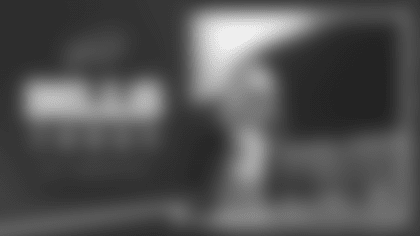Even though the Bills will have a new coordinator calling plays on offense and the scheme along with the protections will largely be the same, there are some potential changes we could witness on Buffalo's offense in the 2022 season. Below we look at the possibilities.
1. Shorter completions
The Bills' passing attack has been a top 10 unit for each of the past two seasons. Yes, Josh Allen can deliver the ball to any part of the field with his arm, but the changes to his receiving corps could prompt a change in the way in which they roll up yards in the passing game.
Buffalo still has two very high-end receivers outside in Stefon Diggs and Gabriel Davis, who is expected to step into a starting role (more on that below). But the depth of strength in the Bills receiving ranks lies inside in the slot.
Tavon Austin, Jamison Crowder, Isaiah Hodgins, Isaiah McKenzie and rookie Khalil Shakir all fit the mold of a slot receiver. Crafty route runners that can gain separation early in the down and know how to exploit space in the voids of a defense.
More importantly most of Buffalo's slot receiver options have run-after-the-catch ability that exceeds their predecessor, Cole Beasley. Austin, Crowder and McKenzie all have plus to elite speed that can be employed after the catch is made. It makes a short completion a greater chance to be much more than that.
That's why Josh Allen, who has largely been a "put it on him" thrower when targeting his receivers, has made throwing a receiver open his primary focus this offseason.
"Making sure I'm on time, making the right reads and giving our guys good enough balls to get some more RAC (run after catch)," said Allen. "That's one thing I think, on offense, run after catch wasn't very high last year, but again, that's me putting the ball where it needs to be and allow our guys to catch in a good position to make a run after the catch. So, working on that, that's been one of my biggest takeaways in this offseason and trying to work on just ball placement and allowing our receivers to do that."
Buffalo ranked 20th in yards after the catch in 2021 with 1,757. They ranked last in the league in yards after the catch per completion managing just 4.24 yards. Raising that total, if it is an offensive priority, could be rooted in more high percentage throws that are shorter in air yards.
The main description of offensive coordinator Ken Dorsey by his players is that he's aggressive. Some might assume that means more shots down the field with a quarterback more than capable of throwing deep. But knowing raising the yards after catch total is a point of emphasis for Allen, the best way to manufacture it is with shorter passes and lining up more players with escape ability.
The Bills have route separators in Diggs and Davis, but Austin, Crowder, McKenzie and Shakir are all able to shake free from man coverage defenders. A deeper contingent of breakaway separators, particularly inside figures to facilitate shorter completions to roll up more yards post reception.
2. More varied personnel groupings
That deep receiving corps was only augmented with the additions made at the other offensive skill positions. OJ Howard, Duke Johnson and James Cook offer additional pass catching ability that will only encourage coordinator Ken Dorsey to mix up the personnel groupings week to week, series to series and sometimes down to down.
"We've got guys all over the field that can make some plays now," said Allen. "If you look at the depth from the running backs to the tight ends to the receivers, the guys have shown they've made plays in the league before. And we've got some rookies that are coming along and continuing to improve and impress these coaches."
That comment by Allen points directly at Cook, who was a dynamic pass catching threat out of the backfield and lined up wide for the national champion Georgia Bulldogs. Averaging almost 12 yards per reception his last two seasons in the SEC, Cook could offer a different dimension and matchup problem to Buffalo's passing game.
Many outside observers wonder if Buffalo will make more use of two back sets would seem to be possible with the pass catching exploits of Cook and Johnson out of the offensive backfield. More two tight end sets are also on the table with Howard now a capable pairing with Dawson Knox at tight end.
And the depth at slot receiver could prompt a return to more four-wide sets after the Bills moved away from it following their Week 1 loss to Pittsburgh last season.
"The nice thing about it for us is we have a lot of different ways of doing it, whether it's personnel packages, formations or splits or route adjustments," said Dorsey. "We have a lot of different ways to do our core stuff and that's the exciting part about it. We got things that guys believe in so when you call it, no matter what the situation is, they have the utmost confidence in executing it."
3. Larger roles for Davis and McKenzie
The expanded role for Davis is obvious. With the offseason departures of veterans Emmanuel Sanders and Cole Beasley, Davis is the most obvious choice to ascend into the number two receiving role opposite Diggs.
"I had some of the best guys who ever played the game give me pointers throughout my past two years being under them," said Davis. "I'm excited now to step up and play that role and be able to use what they gave me in order to execute. I want everybody on that team to know when I'm out there on the field, they're going to get my best and they can trust me when I'm out there to win the matchup."
"The dude just works," said Allen of Davis. "He just works hard. He's a great dude. Selfless. He'll run the for the love of the game routes where he knows he's not getting the ball but he's attracting a safety and allowing someone else to get open. When the play's there to be made, he usually makes them and that's from his hard work and his resiliency his first two years in the league. The dude just continues to make plays and I love the guy to death."
Davis has led the team in receiving average in each of the last two seasons averaging 22 and 17 yards per catch. He also ranked second in the league in explosive play rate according to Sports Info Solutions.
McKenzie is also in line for more snaps on offense this season and has unquestionably earned the opportunity. In the two times McKenzie was called upon to start in Buffalo's offense, the diminutive receiver delivered. In the season finale in 2020 against the Dolphins, McKenzie logged six receptions for 65 yards and two touchdowns. Filling in for Beasley in Week 16 at New England last season, McKenzie was a critical contributor with 11 receptions on 12 targets for 125 yards and a touchdown.
"Josh was very intrigued in what I can do now that Bease is gone," said McKenzie. "We've been on the same page so far and I want to keep it that way. We're communicating like him and Bease were communicating. I want that chemistry that they had the past few years. I want that. When camp comes, I want to keep communicating with him and keep learning from him and just help the team win the best way I can."
McKenzie is expected to compete with veteran Jamison Crowder for the primary slot role left behind by Beasley, but McKenzie figures to still be utilized in different ways by Dorsey in much the same way Brian Daboll deployed him.
"When you've got great playmakers and you have great talent, how do we get them in space," Dorsey asked rhetorically. "What are the best ways to get them the ball? At times don't overcomplicate it, let those guys be who they are and do what they do."















